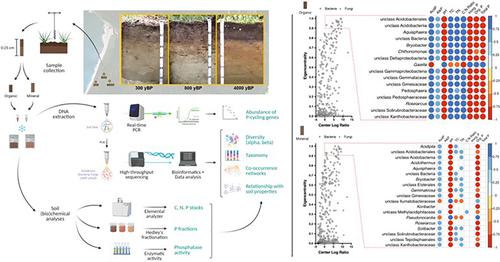当前位置:
X-MOL 学术
›
Environ. Microbiol.
›
论文详情
Our official English website, www.x-mol.net, welcomes your feedback! (Note: you will need to create a separate account there.)
Differential structure and function of phosphorus‐mineralizing microbial communities in organic and upper mineral soil horizons across a temperate rainforest chronosequence
Environmental Microbiology ( IF 5.1 ) Pub Date : 2024-03-14 , DOI: 10.1111/1462-2920.16600 Kari E. Dunfield 1 , Eduardo K. Mitter 1 , Alan E. Richardson 2 , Jonathan R. Gaiero 1 , Kamini Khosla 1 , Xiaodong Chen 3 , Andrew Wells 4 , Philip M. Haygarth 5 , Leo M. Condron 4
Environmental Microbiology ( IF 5.1 ) Pub Date : 2024-03-14 , DOI: 10.1111/1462-2920.16600 Kari E. Dunfield 1 , Eduardo K. Mitter 1 , Alan E. Richardson 2 , Jonathan R. Gaiero 1 , Kamini Khosla 1 , Xiaodong Chen 3 , Andrew Wells 4 , Philip M. Haygarth 5 , Leo M. Condron 4
Affiliation

|
Microbial community structure and function were assessed in the organic and upper mineral soil across a ~4000‐year dune‐based chronosequence at Big Bay, New Zealand, where total P declined and the proportional contribution of organic soil in the profile increased with time. We hypothesized that the organic and mineral soils would show divergent community evolution over time with a greater dependency on the functionality of phosphatase genes in the organic soil layer as it developed. The structure of bacterial, fungal, and phosphatase‐harbouring communities was examined in both horizons across 3 dunes using amplicon sequencing, network analysis, and qPCR. The soils showed a decline in pH and total phosphorus (P) over time with an increase in phosphatase activity. The organic horizon had a wider diversity of Class A (phoN /phoC ) and phoD ‐harbouring communities and a more complex microbiome, with hub taxa that correlated with P. Bacterial diversity declined in both horizons over time, with enrichment of Planctomycetes and Acidobacteria. More complex fungal communities were evident in the youngest dune, transitioning to a dominance of Ascomycota in both soil horizons. Higher phosphatase activity in older dunes was driven by less diverse P‐mineralizing communities, especially in the organic horizon.
中文翻译:

温带雨林年代序列有机土和上层矿土层磷矿化微生物群落的差异结构和功能
对新西兰大湾约 4000 年沙丘年代序列的有机土和上层矿质土壤中的微生物群落结构和功能进行了评估,其中总磷下降,而有机土壤在剖面中的比例贡献随着时间的推移而增加。我们假设,随着时间的推移,有机土壤和矿质土壤将表现出不同的群落进化,并且在发展过程中更加依赖于有机土壤层中磷酸酶基因的功能。使用扩增子测序、网络分析和 qPCR 在 3 个沙丘的两个视野中检查了细菌、真菌和磷酸酶窝藏群落的结构。随着时间的推移,土壤 pH 值和总磷 (P) 下降,磷酸酶活性增加。有机地平线具有更广泛的 A 类多样性(电话号码 /磷酸酶 ) 和磷酸酶 ‐包含群落和更复杂的微生物组,其中心分类单元与 P 相关。随着时间的推移,两个视野中的细菌多样性都下降,随着浮霉菌和酸杆菌的富集。最年轻的沙丘中明显存在更复杂的真菌群落,在两个土壤层中都转变为子囊菌的主导地位。老沙丘中较高的磷酸酶活性是由磷矿化群落多样性较低驱动的,尤其是在有机地层中。
更新日期:2024-03-14
中文翻译:

温带雨林年代序列有机土和上层矿土层磷矿化微生物群落的差异结构和功能
对新西兰大湾约 4000 年沙丘年代序列的有机土和上层矿质土壤中的微生物群落结构和功能进行了评估,其中总磷下降,而有机土壤在剖面中的比例贡献随着时间的推移而增加。我们假设,随着时间的推移,有机土壤和矿质土壤将表现出不同的群落进化,并且在发展过程中更加依赖于有机土壤层中磷酸酶基因的功能。使用扩增子测序、网络分析和 qPCR 在 3 个沙丘的两个视野中检查了细菌、真菌和磷酸酶窝藏群落的结构。随着时间的推移,土壤 pH 值和总磷 (P) 下降,磷酸酶活性增加。有机地平线具有更广泛的 A 类多样性(



























 京公网安备 11010802027423号
京公网安备 11010802027423号